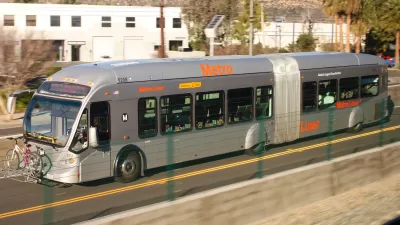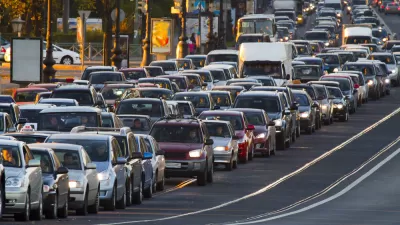The American Public Transit Association reports that transit ridership climbed to 10.3 billion trips during the first quarter of 2008, the “highest number of trips taken in fifty years.” That represents a 3.3 percent increase overall over the previous year while vehicle miles traveled, a measure of demand for car travel, fell by 2.3 percent, they observe.
The American Public Transit Association reports that transit ridership climbed to 10.3 billion trips during the first quarter of 2008, the "highest number of trips taken in fifty years." That represents a 3.3 percent increase overall over the previous year while vehicle miles traveled, a measure of demand for car travel, fell by 2.3 percent, they observe.
But what do these statistics mean for US travel more generally? Not much. At best, they reinforce transit's modern-day role as a niche transportation choice. At worst, they're a harbinger of transit's continued long-term decline. Here's why.
First, let's acknowledge that the increase in ridership is significant. If we convert ridership into passenger miles traveled-a distance-based rather than trip-based measure-a 3.3 percent increase translates into 1.6 billion passenger miles over the course of a year. That's a lot, particularly given the hurdles faced by transit in a high-end, services-based economy that demands more transportation flexibility and generates complex travel patterns. (This, btw, is the subject of my next book, Mobility First, due out this November.)
Yet, APTA's juxtaposition of the two numbers-transit ridership (trips) versus vehicle miles traveled (distance)-is misleading. Their reporting incorrectly implies that public transit is gaining on automobile travel. It isn't. In fact, it's losing ground. Transit's market share of all travel fell from 1.5% of all travel in 1980 to 1.0% in 2005 according to the U.S. Department of Transportation. Even with the gains in ridership, transit would be lucky to maintain its current market share, let alone forestall its long-term decline.
Public transit's gains also pale in comparison to the reduction in road-based travel. US travelers eliminated 112 billion passenger miles from our roadways in 2007. Fewer than 2 percent of those trips might have shifted to public transit even if we assume all of those passenger miles migrated onto buses and trains.
Notably, APTA pointed out that light rail, commuter rail, and heavy rail experience significant increases. But light rail only accounts for 3.4% of transit passenger miles nationally. Commuter and heavy rail together account for almost half of public transit ridership, but their growth was just 5.7% and 4.4% respectfully. Gas prices, in contrast, have increased by about 50 cents (14%) over the last year.
So, anyway you slice the pie, public transit's gains are much more modest than APTA's press release suggests, and the impact on overall travel patterns is minor despite higher gas prices. The data show that the public is not exactly "embracing" transit as an alternative to higher gas prices. Rather, they are simply cutting down on travel. It's not time to re-plan our regions based on or around transit's resurgence.

Maui's Vacation Rental Debate Turns Ugly
Verbal attacks, misinformation campaigns and fistfights plague a high-stakes debate to convert thousands of vacation rentals into long-term housing.

Planetizen Federal Action Tracker
A weekly monitor of how Trump’s orders and actions are impacting planners and planning in America.

Chicago’s Ghost Rails
Just beneath the surface of the modern city lie the remnants of its expansive early 20th-century streetcar system.

Bend, Oregon Zoning Reforms Prioritize Small-Scale Housing
The city altered its zoning code to allow multi-family housing and eliminated parking mandates citywide.

Amtrak Cutting Jobs, Funding to High-Speed Rail
The agency plans to cut 10 percent of its workforce and has confirmed it will not fund new high-speed rail projects.

LA Denies Basic Services to Unhoused Residents
The city has repeatedly failed to respond to requests for trash pickup at encampment sites, and eliminated a program that provided mobile showers and toilets.
Urban Design for Planners 1: Software Tools
This six-course series explores essential urban design concepts using open source software and equips planners with the tools they need to participate fully in the urban design process.
Planning for Universal Design
Learn the tools for implementing Universal Design in planning regulations.
planning NEXT
Appalachian Highlands Housing Partners
Mpact (founded as Rail~Volution)
City of Camden Redevelopment Agency
City of Astoria
City of Portland
City of Laramie






























